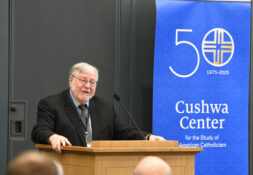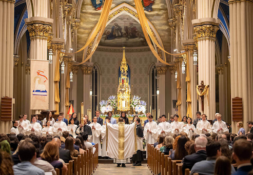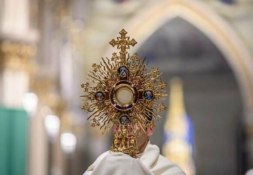Students consecrate themselves in the Year of St. Joseph
In the wake of Pope Francis’s declaration of St. Joseph as the patron of this liturgical year, many Catholics have decided to consecrate themselves to St. Joseph. But what does this mean?
Fr. Donald Calloway, MIC, who wrote a guide entitled Consecration to St. Joseph in 2019, describes Josephite consecration as “acknowledg[ing] that he is your spiritual father, and you want to be like him” (Consecration to St. Joseph, 17). Total consecration to St. Joseph means entrusting your life to him, and letting him lead you to greater holiness. Practically speaking, consecration can be done in many different ways, and a simple prayer commending yourself to St. Joseph is enough, although many people engage in a formal period of reflection and preparation before consecration. The Church has a long tradition of venerating St. Joseph, exemplified by Sts. Bernard of Clairvaux, John of the Cross, Pope John XXIII, Andre Bessette, and Teresa of Avila.
St. Teresa expressed her great devotion to St. Joseph in her Autobiography: “I took for my patron and lord the glorious St. Joseph, and recommended myself earnestly to him. I saw clearly that both out of this my present trouble, and out of others of greater importance, relating to my honour and the loss of my soul, this my father and lord delivered me, and rendered me greater services than I knew how to ask for” (Autobiography of St. Teresa of Avila, Chapter 6). Many other medieval saints also venerated St. Joseph as an intercessor and model of virtue, but he was not revered as he is today until relatively recently.
Devotion to St. Joseph has radically increased in the last 150 years, through a timeline of events including the founding of the Josphites, the apparitions of the Holy Family at Knock, numerous encyclicals, and the founding of the Montreal oratory dedicated to St. Joseph by St. Andre Bessette. Recently, formal consecration to St. Joseph was particularly popularized by Fr. Donald Calloway, MIC, who wrote a guide entitled Consecration to St. Joseph in 2019. The guide is organized in the same way as the 33-day preparation for consecration to the Blessed Mother designed by St. Louis de Montfort. All of the students interviewed for this article read Consecration to St. Joseph in preparation for their consecrations.
Junior Mary Mueller found that her relationship with St. Joseph and her appreciation for his particular virtues and holiness grew through the consecration.
“My relationship to St. Joseph before consecration was mediocre. I knew he was there, but Mary usually gets all the coverage,” she said. “Consecration greatly changed my relationship with this amazing saint and spiritual father. I now run to St. Joseph when I have a request, but I also see him as a courageous model for the interior life and for all fatherhood. His purity, prudence, and protection over his loved ones inspires me to be like him and to surround myself with people that have his virtues.”
Mueller was quick to clarify that, though she is also consecrated to the Blessed Mother, her consecration to St. Joseph does not distract her from her devotion to Blessed Mother
“It actually made me love her more because I am able to love her like Joseph loved her and see her through the lens of being a spouse to him. Now that I have consecrated myself to the whole Holy Family, I see more clearly what shaped Jesus’ heart as a child. Joseph and Mary gave their purity and self-sacrificial love to Jesus, and so by seeing these parents, I see Christ,” said Mueller.
Consecration to St. Joseph extends beyond simple spiritual edification; it transforms the consecree and opens their eyes to the Holy Family’s perfect charity and devotion. St. Joseph is not only an exemplar for the heroic virtues of purity, prudence, and self-sacrificial love, but also a model for true humility. St. Joseph lived a life of poverty of spirit, standing in the shadows of Christ and the Blessed Mother, quietly defending and supporting them. Most details of his life escape us, and he is totally silent in the Gospel. By his example, he calls us to love the ordinary life, hidden from the world and its pride.
“St. Joseph, while of course charged with a very special duty to serve as foster father to Our Lord, spent most of his life working a fairly humble profession and living a holy family life,” said sophomore Alex Cattaneo. “He provides a model of how to live such a humble life while growing in sanctity.” He is the only sinner in the Holy Family, and therefore the model for all of us who are fallen but still desire to love God more fully.
In addition to helping us appreciate St. Joseph as a model and an intercessor, consecration invites one into a deep and enduring spiritual friendship. Especially when it comes to total consecration, spiritual friendships with saints require dedication and a willingness to make sacrifices. They necessitate endurance and humility in the knowledge that sometimes it will be a meandering and winding path to intimate spiritual friendship.
“Relationships are, as my Carmelite spiritual director and pastor once told me, a kind of dance. One person takes one step, and the other person takes a step in equal proportion to the first. Relationships with people, and with saints in this regard, have to develop in an organic way. We can’t just make ourselves be devoted to a saint in a day; rather, we must walk with a saint throughout the mundane and exciting moments of our lives to grow in appreciation for him or her,” mused senior Bea Cuasay.
Consecration does not end on the 33rd day; rather, that day is the beginning of a lifelong spiritual accompaniment through both peaks and troughs, the beginning of a profound and abiding friendship.
Maria is a junior PLS and Medieval Studies major who loves smoked salmon, Brideshead Revisited, and po-ta-toes. If you ever want to talk about Augustine, Platonism, or the unshakeable desire to leave your studies behind and become a Desert Father, she can be reached at mkeller7@nd.edu.






Leave a Reply